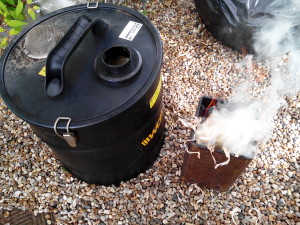The process of smoking food was begun out of simple survival. Meats hung in smoky huts and caves were found to last longer than ‘unpreserved’ meats. This accidental discovery from a smoky fire gave early man a way of saving food in times of plenty, and became a part of the survival of the fittest, or cleverest.
Smoking now offers a way of improving or changing the taste of foods. Unfortunately, this also has led to artificial smoking, where food is dipped or sprayed with artificial smoke flavouring.
A few years ago I saw a programme with Dick Strawbridge ( a bit of a hero of mine, from his Scrapheap Challenge days, through to a number of programmes around sustainable living), where he, and his son James, made a simple smoker from a barrel. I was then given their ‘smoking’ book last Christmas and I was away.
Following our principles of doing what we can for ourselves, I decided that it really was simple and would give it a go. I started with a ‘hot coal vacuum cleaner extension’ from Aldi (our favourite supermarket, but that’s another post), for my drum, and then made a cold smoking container on my forge, based on a bee smoker. Hey presto, a food smoker was born.
We have some friends visiting from Germany this week, so the smoker came out yesterday in preparation. Smoked food is much better if left for a day or two; it allows the smoke to permeate into the food and become smoother in taste.
I use hard woods for smoker fuel, a by-product of my wood carving, as softwoods contain excess tar that makes the food taste bitter.
 Stage 1 for wild salmon fillets is to cure in a sugar and salt mix for 6 hours. This pulls out moisture from the fish and begins the curing process.
Stage 1 for wild salmon fillets is to cure in a sugar and salt mix for 6 hours. This pulls out moisture from the fish and begins the curing process.
 Stage 2 and it is loaded into the drum. The fish is going onto the bottom, so that it doesn’t drip onto the cheese and other foods.
Stage 2 and it is loaded into the drum. The fish is going onto the bottom, so that it doesn’t drip onto the cheese and other foods.
 Stage 3 and the cheese, eggs and garlic go onto the second shelf. Note that anything likely to drip is in an aluminium food container.
Stage 3 and the cheese, eggs and garlic go onto the second shelf. Note that anything likely to drip is in an aluminium food container.
 Stage 4 and the separate fire box is alight. As noted above, it is designed to work exactly like my bee smoker, providing cold smoke to the food.
Stage 4 and the separate fire box is alight. As noted above, it is designed to work exactly like my bee smoker, providing cold smoke to the food.
 Stage 5 and the smoke is directed through a tube into the main container and out through a grill (OK, its a tea strainer I bought in a pound shop). This stops any undesirables flying into the food.
Stage 5 and the smoke is directed through a tube into the main container and out through a grill (OK, its a tea strainer I bought in a pound shop). This stops any undesirables flying into the food.
As the fire box is quite small I refill it after abut 30 minutes. This gives me a total smoking time of about 1 hour to 1 1/2 hours. This is much less than some recommend but I find that it is surprising how little smoke is required to give a good smoky taste, against smoking for preservation.

 And here they are, the finished smoked products. I won’t go on about how lovely they taste, but just try a couple of cloves of smoked garlic next time you cook, or egg sandwiches with smoked egg mayonnaise. Delicious.
And here they are, the finished smoked products. I won’t go on about how lovely they taste, but just try a couple of cloves of smoked garlic next time you cook, or egg sandwiches with smoked egg mayonnaise. Delicious.
